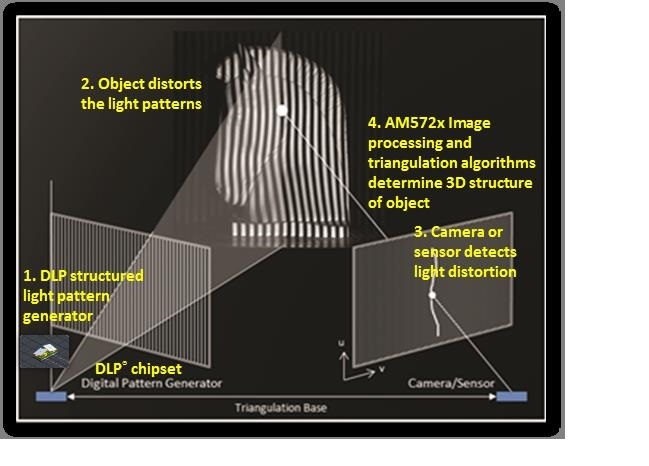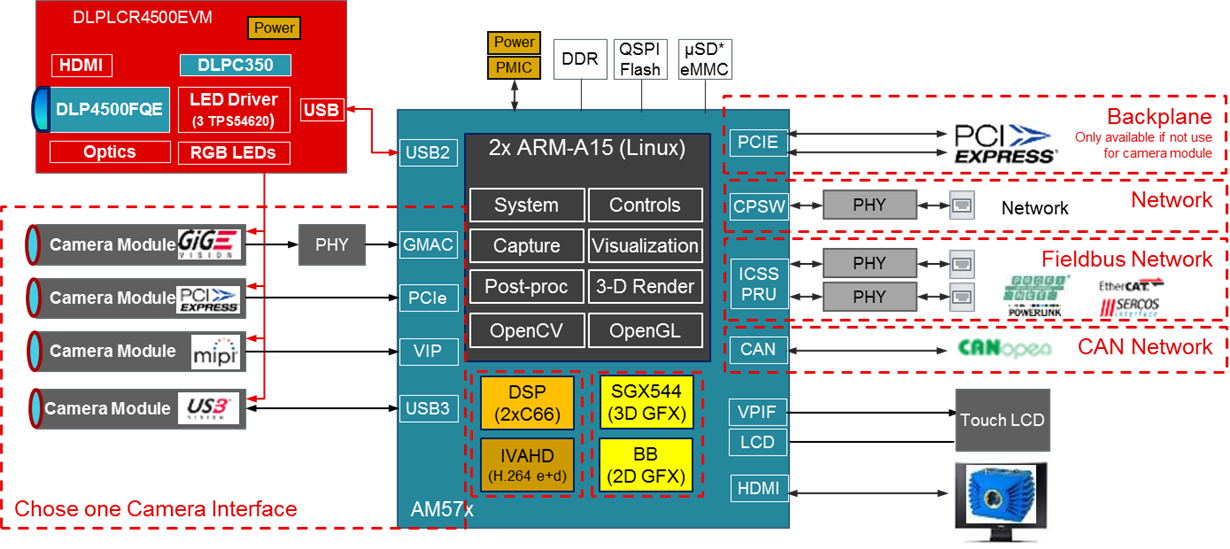Bringing Fast, Accurate 3D Scanning into Embedded Applications
Mark Nadeski
3D scanning technology continues to rise as more industries find ways to take advantage of the usefulness of having 3D representations. The depth and detail provided by 3D measurements are extremely useful in areas of industrial inspection and factory automation and lead to improvements in failure analysis, increased productivity and profit. Outside of these areas, applications for 3D scanning exist from the obvious, like the 3D printing space, to the relatively obscure, like dental scanning.

In all these spaces, the structured light approach offers advantages of improved depth accuracy, high resolution and high speed when compared with other 3D measurement technologies like stereoscopic vision and laser triangulation. While stereoscopic vision suffers from algorithm complexity and laser triangulation can require moving objects, structured light does not have either of these limitations. Based on TI’s digital micromirror device (DMD) technology, a DLP® technology structured light pattern generator can project precise patterns onto the to-be-measured object at a high speed and in a very reliable way. Also the ability of working with a wide wavelength range of light from near infrared, to visible, to ultraviolet provides great flexibility to adapt for many different types of materials and applications.
The usage of structured light for 3D scanning is nothing new. But as the use of 3D scanning becomes more popular and more industries are looking to leverage it, there are now requirements for and benefits from creating an embedded system with this technology. To satisfy the needs of embedded systems, power, size and cost become integral parts of the solution. This generally places constraints on the type of processor that can be utilized.
TI’s new Sitara™ AM572x processor system on chip (SoC) complements the DLP LightCrafter™ 4500 evaluation module (EVM) to enable an embedded 3D machine vision solution. A new TI Design reference design for a 3D scanner based on the AM572x processor SoC with DLP technology structured light shows a working system where all the processing is done on the AM572x processor SoC. Below is an illustration of how such a system would look.

The AM572x processor SoC has two ARM® Cortex®-A15 processors and two C66x DSP cores. The ARM processors take care of running a high level OS, controlling the image acquisition and performing the 3D machine vision processing. The C66x DSP cores can be used for efficiently offloading the ARM cores and are well suited for performing the geometric calculations for depth information, generating the 3D point cloud, extracting object features and running complex analytic algorithms. The AM572x processor also provides 3D graphics acceleration and a display subsystem for object feature visualization. Utilizing the AM572x processor enables a reduction in power, size and cost of traditional PC-based solutions and enables a 3D scanning solution in an embedded environment.
The DLP LightCrafter 4500 EVM provides a flexible light steering solution for industrial, medical and scientific applications. It features the DLP4500 chipset and offers a compelling combination of resolution, brightness and programmability in a small form factor. Developers can easily create, store and display high-speed pattern sequences through DLP LightCrafter 4500’s USB-based application programming interface (API) and easy-to-use graphical user interface (GUI). Two configurable input/output triggers allow for convenient synchronization with cameras, sensors or other peripheral devices. The DLP LightCrafter 4500 EVM’s feature set is a platform that can be used in industrial 3D machine vision scanners, medical imaging devices and much more.
Click on the below to learn more about:
- Download the TI Design reference design for 3D scanning based on the AM572x SoC and the DLP4500-based projector (schematics, test data and design files)
- TI DLP 3D machine vision applications
- Scalable 3D Scanning Solutions with DLP® Technology (Video)
- DLP® Advanced Light Control SDK for LightCrafter series controllers
- DLP LightCrafter 4500 evaluation module
- Sitara AM57x processors
- Sitara AM572x evaluation module
IMPORTANT NOTICE AND DISCLAIMER
TI PROVIDES TECHNICAL AND RELIABILITY DATA (INCLUDING DATASHEETS), DESIGN RESOURCES (INCLUDING REFERENCE DESIGNS), APPLICATION OR OTHER DESIGN ADVICE, WEB TOOLS, SAFETY INFORMATION, AND OTHER RESOURCES “AS IS” AND WITH ALL FAULTS, AND DISCLAIMS ALL WARRANTIES, EXPRESS AND IMPLIED, INCLUDING WITHOUT LIMITATION ANY IMPLIED WARRANTIES OF MERCHANTABILITY, FITNESS FOR A PARTICULAR PURPOSE OR NON-INFRINGEMENT OF THIRD PARTY INTELLECTUAL PROPERTY RIGHTS.
These resources are intended for skilled developers designing with TI products. You are solely responsible for (1) selecting the appropriate TI products for your application, (2) designing, validating and testing your application, and (3) ensuring your application meets applicable standards, and any other safety, security, or other requirements. These resources are subject to change without notice. TI grants you permission to use these resources only for development of an application that uses the TI products described in the resource. Other reproduction and display of these resources is prohibited. No license is granted to any other TI intellectual property right or to any third party intellectual property right. TI disclaims responsibility for, and you will fully indemnify TI and its representatives against, any claims, damages, costs, losses, and liabilities arising out of your use of these resources.
TI’s products are provided subject to TI’s Terms of Sale (www.ti.com/legal/termsofsale.html) or other applicable terms available either on ti.com or provided in conjunction with such TI products. TI’s provision of these resources does not expand or otherwise alter TI’s applicable warranties or warranty disclaimers for TI products.
Mailing Address: Texas Instruments, Post Office Box 655303, Dallas, Texas 75265
Copyright © 2023, Texas Instruments Incorporated